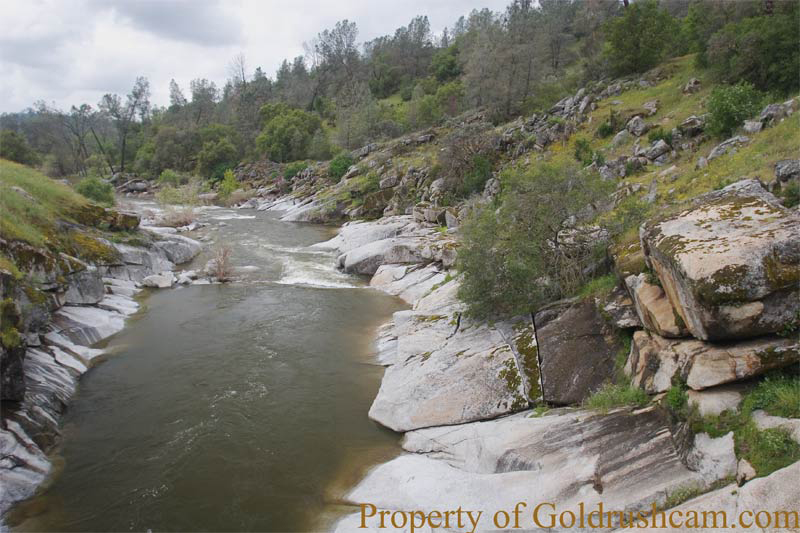
The Chowchilla River flows through a natural granite channel in Madera County on it's way to Eastman Lake after a 65 mile trip from Mariposa County.
August 23, 2016 - SAN FRANCISCO, Calif.— The California Supreme Court yesterday upheld a statewide moratorium on recreational suction dredge mining for gold and said regulations protecting water supplies, fisheries, wildlife and cultural resources from the practice are valid. Suction dredge miners had asked the court to prevent the California Department of Fish and Wildlife from enforcing the current moratorium on the destructive practice. The moratorium, in place since 2009, is designed to prevent mercury pollution and damage to wildlife, waterways and cultural resources caused by suction dredge mining until protective rules are adopted.
“Suction dredging is a continuation of the genocidal legacy of goldminers that started over 150 years ago,” said Leaf Hillman, the Karuk tribe’s director of natural resources. “We will continue the fight to protect our cultural and natural resources from this reckless form of river mining.”
Suction dredge mining uses machines to vacuum up gravel and sand from streams and river bottoms in search of gold. It threatens important cultural resources and sensitive wildlife species, and the California Native American Heritage Commission has condemned its impacts on priceless tribal and archeological resources. It pollutes waterways with mercury and sediment and destroys sensitive habitat for important and imperiled wildlife, including salmon and steelhead trout, California red-legged frogs and sensitive migratory songbirds.
“Suction dredging is a reckless form of hobby mining that tears up rivers and threatens our waterways, imperiled salmon and other wildlife,” said Jonathan Evans, environmental health legal director at the Center for Biological Diversity. “In this time of drought and climate change, we can’t afford to have California’s waterways trashed by a small but vocal group of gold miners.”
The suction dredge mining decision results from the case of The People of the State of California v. Brandon Lance Rinehart, in which a suction dredge miner was convicted of mining without a permit in 2012 in the Plumas National Forest, north of Lake Tahoe. California law prohibits in-stream suction dredge mining until the state develops regulations that will pay for the program and protect water quality, wildlife and cultural resources, and until Clean Water Act permits are issued for the polluting hobby. California agencies have not yet developed those regulations or permits.
The harm done by suction dredging is well documented by scientists and government agencies. It harms state water supplies by re-suspending toxic mercury, sediment and heavy metals. The Environmental Protection Agency and State Water Resources Control Board urged a complete ban on suction dredge mining because of its significant impacts on water quality and wildlife from mercury pollution.
“The unanimous decision handed down by the California Supreme Court this morning correctly holds that state regulations protecting our riverbeds from being vacuumed up by suction dredge gold mining has not been preempted by federal law,” said Friends of the River Senior Counsel Bob Wright. “This is a victory for sanity and common sense as well as the effort to protect our crashing fish populations.”
A coalition of tribal, conservation and fisheries groups have been seeking to uphold California’s laws regulating suction dredge mining. This coalition includes the Center for Biological Diversity, the Karuk tribe, Pacific Coast Federation of Fishermen’s Associations, Institute for Fisheries Resources, Friends of the River, The Sierra Fund, California Sportfishing Protection Alliance, Foothills Anglers Association, North Fork American River Alliance, Upper American River Foundation, Central Sierra Environmental Resource Center, Environmental Law Foundation and Klamath Riverkeeper. Members of the coalition are represented by Lynne Saxton of Saxton & Associates, a water-quality and toxics-enforcement law firm.
The Center for Biological Diversity is a national, nonprofit conservation organization with more than 1.1 million members and online activists dedicated to the protection of endangered species and wild places.
www.biologicaldiversity.org
The Karuk Tribe is the third-largest federally recognized Indian Tribe in California. The Karuk have been in conflict with gold miners since 1850. Karuk territory is along the middle Klamath and Salmon Rivers.
www.karuk.us
Source: Center for Biological Diversity








